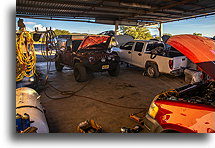Car Broke
October 15-17
Traditionally, we spent the last night before crossing the border in the last rest area on I35. In the morning at the Nuevo Laredo border crossing, we lost some time dealing with formalities, Mexican Tourist Cards for us and the temporary vehicle permit for Balios. Our plan was to spend the next night in Mineral de Pozos, Guanajuato, almost 900 km / 560 miles from the border.



We started our journey through Mexico. In the distance we passed Monterrey and climbed over 2000 m / 6500 ft into the mountains. The temperature reached 38°C / 100°F. Suddenly our Jeep lost power, the accelerator stopped responding properly. Balios was still drivable, but at a very slow speed. We asked a nearby roadside mechanic for help. When he started looking for the cause of the problem, everything came back to normal. No OBDII code showed up. We even did a short test drive, everything was fine. Was it just a loss of contact at the oxygen sensor that the mechanic reattached? We were happy and paid the mechanic 300 pesos and left. Within 5 minutes of driving, exactly the same problem returned. It was getting dark, we had to decide what to do next. We were about 100 km / 50 miles from San Luis Potosi. We decided to go there. There is a Jeep dealer and service in town, we hoped they would be able to identify the problem there. Our Jeep was able to go slower and slower until its top speed was below 10 kmph / 8 mph. Then we stopped and waited for the engine to cool down. Our pattern was a 20-minute drive with a 45-minute break at the roadside. At 4 am we reached the outskirts of San Luis Potosi, constantly on the road for almost 19 hours.



In the end, it turned out that the Bosch throttle body was broken. The original part was not available. Fortunately, we found a replacement. Due to a car problem, we had to spend four days in San Luis Potosí. It was an opportunity to see the historical part of the city. Traditionally in Mexico, each city has several churches from the colonial era, time of New Spain. One of the most important ones here is Our Lady of Mount Carmel Church. Construction of the splendid Baroque church and Carmelite convent completed in 1764. There are statues of 12 Carmelite saints on the façade. Inside there is a richly gilded Baroque wooden altar.



After Mexico gained independence, the monastery was occupied by the military and turned into barracks. In 1857, when the government limited the power of the church and confiscated most of its property, the Carmelite monastery was abandoned. Its buildings were used for secular purposes, the convent gardens were turned into a city park.











